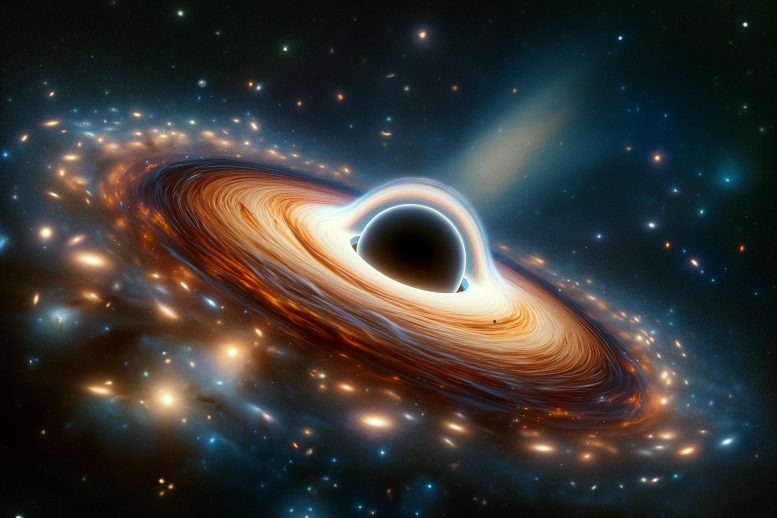
A new study using machine learning reveals that supermassive black-hole growth in galaxies necessitates cold gas in addition to mergers, challenging previous assumptions and enhancing our understanding of galaxy evolution. Credit: SciTechDaily.com
It takes more than a galaxy merger to make a black hole grow and new stars form: machine learning shows cold gas is needed too to initiate rapid growth.
When they are active, supermassive black holes play a crucial role in the way galaxies evolve. Until now, growth was thought to be triggered by the violent collision of two galaxies followed by their merger, however, new research led by the University of Bath suggests galaxy mergers alone are not enough to fuel a black hole – a reservoir of cold gas at the center the host galaxy is needed too.
The new study, published this week in the journal Monthly Notices of the Royal Astronomical Society is believed to be the first to use machine learning to classify galaxy mergers with the specific aim of exploring the relationship between galaxy mergers, supermassive black-hole accretion, and star formation. Until now, mergers were classified (often incorrectly) through human observation alone.
“When humans look for galaxy mergers, they don’t always know what they are looking at and they use a lot of intuition to decide if a merger has happened,” said Mathilda Avirett-Mackenzie, PhD student in the Department of Physics at the University of Bath and first author on the research paper. The study was a collaboration between partners from BiD4BEST (Big Data Applications for Black Hole Evolution Studies), whose Innovative Training Network provides doctorial training in the formation of supermassive black holes.
She added: “By training a machine to classify mergers, you get a much more truthful reading of what galaxies are actually doing.”
Supermassive Black Holes
Supermassive black holes are found in the center of all massive galaxies (to give a sense of scale, the Milky Way, with around 200 billion stars, is only a medium-sized galaxy). These supersized black holes typically weigh between millions and billions of times the mass of our sun.
Through most of their lives, these black holes are quiescent, sitting quietly while matter orbits around them, and having little impact on the galaxy as a whole. But for brief phases in their lives (brief only on an astronomical scale, and most likely lasting millions to hundreds of millions of years), they use gravitation forces to draw large amounts of gas towards them (an event known as accretion), resulting in a bright disk that can outshine the entire galaxy.
It’s these short phases of activity that are most important for galaxy evolution, as the massive amounts of energy released through accretion can impact how stars form in galaxies. For good reason then, establishing what causes a galaxy to move between its two states – quiescent and star-forming – is one of the greatest challenges in astrophysics.
“Determining the role of supermassive black holes in galaxy evolution is crucial in our studies of the universe,” said Ms Avirett-Mackenzie.
Human Inspection vs Machine Learning
For decades, theoretical models have suggested black holes grow when galaxies merge. However, astrophysicists studying the connection between galaxy mergers and black-hole growth over many years have been challenging these models with a simple question: How do we reliably identify mergers of galaxies?
Visual inspection has been the most commonly used method. Human classifiers – either experts or members of the public – observe galaxies and identify high asymmetries or long tidal tails (thin, elongated regions of stars and interstellar gas that extend into space), both of which are associated with galaxy mergers.
However, this observational method is both time-consuming and unreliable, as it’s easy for humans to make mistakes in their classifications. As a result, merger studies often yield contradictory results.
For the new Bath-led study, the researchers set themselves the challenge of improving the way mergers are classified by studying the connection between black-hole growth and galaxy evolution through the use of artificial intelligence.
Inspired by the Human Brain
They trained a neural network (a subset of machine learning inspired by the human brain and mimicking the way biological neurons signal to one another) on simulated galaxy mergers, then applied this model to galaxies observed in the cosmos.
By doing so, they were able to identify mergers without human biases and study the connection between galaxy mergers and black-hole growth. They showed that the neural network outperforms human classifiers in identifying mergers, and in fact, human classifiers tend to mistake regular galaxies for mergers.
Applying this new methodology, the researchers were able to show that mergers are not strongly associated with black-hole growth. Merger signatures are equally common in galaxies with and without accreting supermassive black holes.
Using an extremely large sample of approximately 8,000 accreting black-hole systems – which allowed the team to study the question in much more detail – it was found that mergers led to black-hole growth only in a very specific type of galaxies: star-forming galaxies containing significant amounts of cold gas.
This shows that galaxy mergers alone are not enough to fuel black holes: large amounts of cold gas must also be present to allow the black hole to grow.
Ms Avirett-Mackenzie said: “For galaxies to form stars, they must contain cold gas clouds that are able to collapse into stars. Highly energetic processes like supermassive black-hole accretion heats this gas up, either rendering it too energetic to collapse or blowing it out of the galaxy.”
She added: “On a clear night, you can just about spot this process happening in real-time with the Orion Nebula – a large, star-forming region in our galaxy and the closest of its kind to Earth – where you can see some stars that were formed recently and others that are still forming.”
Dr. Carolin Villforth, senior lecturer in the Department of Physics and Ms. Avirett-Mackenzie’s supervisor at Bath, said: “Until now, everyone was studying mergers the same way – through visual classification. With this method, when using expert classifiers that can spot more subtle features, we were only able to look at a couple of hundred galaxies, no more.
“Using machine learning instead opens up an entirely new and very exciting field where you can analyze thousands of galaxies at a time. You get consistent results over really large samples, and at any given moment, you can look at many different properties of a black hole.”
Reference: “A post-merger enhancement only in star-forming Type 2 Seyfert galaxies: the deep learning view” by M S Avirett-Mackenzie, C Villforth, M Huertas-Company, S Wuyts, D M Alexander, S Bonoli, A Lapi, I E Lopez, C Ramos Almeida and F Shankar, 22 February 2024, Monthly Notices of the Royal Astronomical Society.
DOI: 10.1093/mnras/stae183









Be the first to comment on "Unmasking the Universe With AI: How Machine Learning Unravels Black Hole Mysteries"